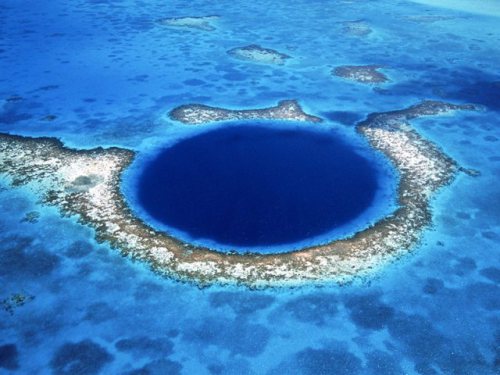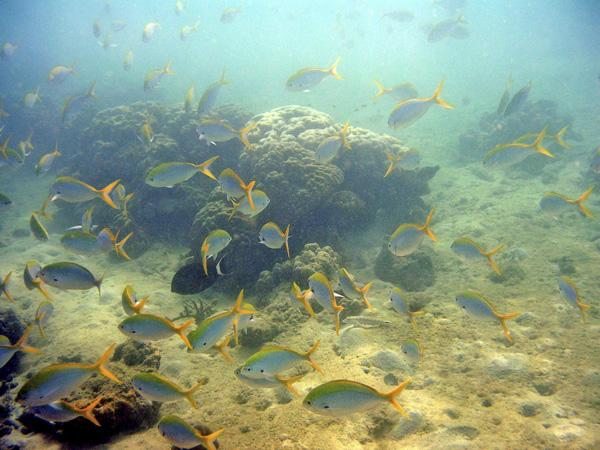Earthquakes
Earthquakes/Tsunamis
Overview
Aside from artificial harm to Coral Reefs, natural events such as hurricanes, cyclones, earthquakes and tsunamis cause significant damage to coral reefs. The wave activity caused by earthquakes and tsunamis cause extreme mechanical damage to corals, breaking apart their structures. Sediment stir-up can limit the amount of sunlight that reaches the corals and flooding can cause dangerous increased depths for corals and nutrient run-off changing water dynamics such as pH and salinity. Branching corals are usually the most succeptible corals to damage from storms and wave activity, because the ends of the corals break off very easily. However, natural events rarely cause the huge wipe-out of entire coral reefs like human-induced events do because storms are a natural part of coral reef ecosystems, so coral species adapt to these natural disturbances. Eutrophication and temperature rise caused by nutrient runoff and global warming can cause the complete destruction of miles and miles of coral reefs. The main problem caused by earthquakes and tsunamis is wave action which causes the different types of damage below. [1]
Types of Damage
1. Mechanical Damage: Direct damage to corals and coral reefs occurs mainly as a result of the mechanical forces extered by the storm-induced waves and currents. All the problems that come from tsunamis and earthquakes are usually caused by mechanical damage to the corals, which perpetuate into other problems. The pieces of coral that break off from wave action cause both changes in sedimentation processes, and increased turbidity. Broken coral pieces also disrupt benthic assemblages lying on the floor of the ocean. The coral broken off create an imbalance of small sedimentation versus large pieces of sedimentation on the coral reef changing the sedimentation processes. The large pieces of coral uproot soft benthic organisms as well. This increase in sedimentation also causes increased turbidity and pieces of debris in the water. [2]
2. Damages Due to Changes in Sedimentation Processes: Mechanical damage to coral reefs and wave action during tsunamis and earthquakes causes an increase in coarse sedimentary material from broken corals and uprooted soft benthic organisms as well as a redistribution of existing sediments. Increased sedimentation can (1) smother marine communities and in severe cases, completely bury them, leading to suffocation, of not only corals, but mangrove stands and sea grass beds as well, (2) decrease the amount of available sunlight which may in turn limit the production of algae and macrophytes, increase water temperatures and reduce growth of natural vegetation, and (3) damage fish by irritating or scouring their gills and degrade fish habitats by reducing available oxygen. A decrease in sedimentation also is problematic and can lead to a degradation of an ecosystem by starving it of the elements needed to sustain production since sediments often carry a variety of minerals, nutrients and organic matter. [3]
3. Damage Due to Increased Turbidity: One of the main requirements of healthy coral reefs is clear, clean water. This is essential to the important symbiosis between coral and zooxanthellae. The zooxanthellae uses photosynthesis to provide the coral with food. With decreased sunlight, it is harder for the zooxanthellae to produce food, essentially starving the corals. Also, if the corals become stressed from other factors such as decreased salinity in addition to a lack of sunlight, it could expel the zooxanthellae from the coral, which in turn usually kills it. Earthquakes and tsunamis cause sediment to mix into the water, decreasing the amount of light that can reach the already damaged corals [4]
4. Damage due to Decreased Salinity and Imbalance of Nutrients: Extreme flooding caused by tsunamis can bring into the water nutrients and waste from the land surrounding the corals, causing the imbalance of nutrients in the water and decreased salinity. Corals also require a specific nutrient level, pH level and salinity to survive. Tsunamis and flooding can have the potential to severely alter all of these factors [5]
5. Damage Due to Change in Sea Level: Changes in tidal flow and a fall or rise in sea level can cause severe damage to corals. If sea levels rise, the corals are now at an unfavorable depth. This new depth can change the temperature that the corals are in, and can severely alter the amount of sunlight that can reach the coral. As said before, decreased sunlight makes it harder for the zooxanthellae to make food and starves the corals. Conversely, if sea level drops, the corals can be exposed to much warmer water that they aren't used to or can be exposed to land. The corals can essentially become "burnt" by the sun and become to stressed to survive. Some corals are able to develop a protective coating around themselves to combat against a drop in sea level. However, the corals can only maintain this outer coating for so long and with other stressors that come with earthquakes and tsunamis such as extreme mechanical damage, the corals can become too stressed to develop and maintain this coating and die altogether. [6]
History of Earthquakes in the Caribbean - Important Case Study
In May of 2009, a powerful magnitude 7.3 earthquake hit Honduras and caused widespread damage as far as the Belizean Barrier Reef. Prior to this event, two dominant species of coral were completely eradicated from other causes but the loss of these species made the young, new dominant coral less resilient to the earthquake's destruction. The earthquake destroyed ten benthic assemblages in the Belizean Barrier Reef and destroyed another by causing avalanching of slopes within the reef. Avalanching of reef slopes is when reef debris attaches to another part of the reef, then breaks apart into many many pieces. The reef is then surrounded by a debris field, consisting of complied reef debris. During the earthquake, benthic organisms were removed and buried by the uplifted sediment. Only sediment and skeletal debris remained afterwards, and the living cover in coral decreased by sixty percent. This catastrophe caused an extreme change in the coral reef's ecology and community, causing widespread damage and dieoff within the reef. Scientists estimated the recovery time of approximately 2,000 years. This is an example of a series of unfortunate events. Richard Aronson, of the Florida Institute of Technology explains that “The prior losses of both staghorn and lettuce corals drastically weakened the resilience of the coral assemblages on the reef slopes. In other words, if neither white-band disease nor bleaching had occurred, staghorn coral might have continued its millennial-scale dominance of the areas not destroyed by the quake.” [7] The reef is expected to return, but it is impossible to determine the species of coral that will become dominant and the new ecosystem that will develop there. The recovery will likely take centuries to millennia instead of decades. Corals, similar to everything on this planet have the capacity to adapt. Their adaptation becomes more difficult after a powerful storm hits an area that already has damage, like in this study.
A shot of a Belizian Reef:
History of Tsunamis in the Caribbean - Important Case Study
The earthquake and subsequent tsunami of 2004 severely impacted coral reefs in the Indian Ocean, especially coral reefs lying along the Nicobar Islands. Damage was recorded at 14 different sites along the islands following the earthquake and tsunami. Acropora coral significantly declined around the area. Algal cover also increased in the areas that experienced the highest coral mortality, possibly indicating a shift from a coral dominated community to a permanent algal dominated community. [9]
A shot of a Nicobar Island Reef:
References
[1] Marion McClary (Topic Editor) "Threats to coral reefs". In: Encyclopedia of Earth. Eds. Cutler J. Cleveland (Washington, D.C.: Environmental Information Coalition, National Council for Science and the Environment). [First published in the Encyclopedia of Earth August 25, 2008; Last revised Date July 14, 2012; Retrieved February 25, 2013 <http://www.eoearth.org/article/Threats_to_coral_reefs?topic=49513>
[2-7] Harmelin-Vivien, ML. The effects of storms and cyclones on coral reefs: a review. Journal of Coastal Research [Internet]. 1994 [cited 2013 Feb 26]; Special Issue No. 12: 211-231. Available from: http://www.istor.org/stable/25735600
[8] Catastrophe and the life span of coral reefs, Richard B. Aronson, William F. Precht, Ian G. Macintyre, and Lauren T. Toth, Ecology 2012 93:2, 303-313
[9] Picture from: http://repeatingislands.com/2011/09/13/belizean-reefs-destroyed-by-2009-honduran-earthquake/
[10] Patankar V, D'Souza E, Kumaraguru A, Arthur R. Distance-related thresholds and influence of the 2004 tsunami on damage and recovery patterns of coral reefs in the Nicobar Islands. Current Science (00113891) [serial online]. April 25, 2012;102(8):1199-1205. Available from: Academic Search Complete, Ipswich, MA. Accessed February 27, 2013.
[11] Picture from: http://www.cengage.com.br/gale/globalissues/slideshow.htm

